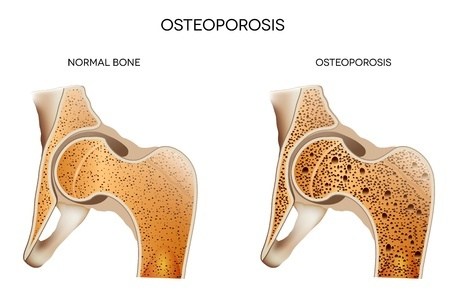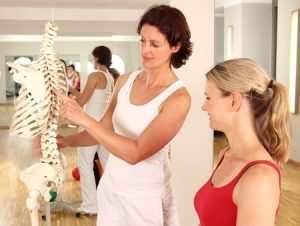Approximately 54 million Americans have osteoporosis or low bone mass, placing them at increased risk for osteoporosis. This often-silent disease causes bones to become weak and fragile. Typically, there are no symptoms to indicate someone is developing osteoporosis. Oftentimes, people aren’t diagnosed until they have a fracture, and by that point it’s too late. As personal trainers, we are an important part of helping our clients prevent osteoporosis.
Weak bones easily fracture, the most common fractures occur in the hip, spine, and wrist. Each year over a million fractures are attributed to osteoporosis costing over $17 billion in acute and long-term care expenses. Post-fracture recovery can be difficult and it can create a diminished quality of life
Our female clients are most affected by this disease although osteoporosis can affect anyone. Women at the greatest risk are Asian women who are over 70 years old.
There are two different types of risk factors, modified and fixed. Having one of the risk factors or even a few does not mean that you are destined to develop osteoporosis, however your odds are increased.
Fixed risks for osteoporosis
Although these risks are fixed and not much we can do as trainers to help there are precautions that can be taken to reduce bone mineral loss.
- Age – Risk becomes greater with age
- Gender – Women are at higher risk
- Family History
- Previous Fractures
- Ethnicity – Asian and Caucasians are at higher risk
- Menopause
- Rheumatoid Arthritis
- There are many health issues that can rob your bones of calcium, be sure to talk to ask your Dr. about keeping your bones healthy.

Modifiable risks for osteoporosis
Through lifestyle modifications we can help our clients reduce their risk by taking the following steps.
- Alcohol – Eliminate or Reduce Intake
- Smoking – You shouldn’t be smoking anyway! Don’t you see the commercial of the lady talking through her throat tube? Come on!
- Low Body Mass Index – Being underweight increases risk
- Poor Nutrition – Not getting enough minerals in your diet
- Vitamin D Deficiency – Over 50% of women diagnosed had low D levels
- Eating Disorders
- Insufficient Exercise – Weight-bearing exercise increases bone density
- Not Eating Enough Protein – Protein is 50% of your bone.
- Low Calcium Intake – Calcium is a very important mineral for bone health. If you don’t get enough from your diet consider supplementation.
- Certain medications can cause increased bone loss, be sure to check with your Dr. and give them a full history of the medications you are taking

Preventing osteoporosis
There are steps our clients can take to greatly reduce the risk of developing osteoporosis, however, it is not 100% preventable. Although diagnosing osteoporosis is their physicians job, it is important to bring up the issue especially if your client has any risk factors mentioned above. Here are some ways to help them minimize their risk of developing osteoporosis in your role as a personal trainer.
- Pull the Plug on added Sugar. Sugar doesn’t have any nutritional benefit and furthermore, it depletes your body of phosphorus, which is an important mineral for calcium absorption.
- Consume a minimum of 1,200mg per day of Calcium. Foods rich in calcium are greens: collard greens, turnip greens, Chinese cabbage, kale, okra, dandelion greens, and broccoli. Spinach, although it has calcium, contains oxalates, which rob the mineral from your body so it is not advisable on an osteoporosis diet.
- Resistance training (NOT CARDIO) will help increase your bone density.
- The main way our bodies create Vitamin D is from exposure to sunlight. When the rays hit our skin our bodies naturally create vitamin D. But most of us don’t get outside enough and when we do we lather on toxic sunscreen that blocks the production of vitamin D. Eat a diet high in vitamin D –foods such as wild salmon, grass fed beef, egg yolks, dairy, and organ meat or consider supplementation. Make sure to get vitamin D with K2.
- Don’t Drink or Smoke. If you are at high risk or have osteoporosis cut these out immediately.
- Reduce or Eliminate Caffeine if you get an adequate amount of calcium in your diet, one cup of a caffeinated beverage is OK. You lose about 6mg of calcium for every 100mg of caffeine.
- Ask your Dr. for a Bone Mineral Density Test of BMD to determine your current state of bone health.
Personal trainers who pay attention enhance prevention
Millions of people will find out too late that they have Osteoporosis. It’s your job as trainers to help your clients reduce their lifestyle related risk factors. Most of these are things that we are already telling our clients such as don’t smoke, limit sugar and caffeine, and doing resistance training. Breaking a hip is often the start of the slippery slope that can end in your client losing their independence and you losing a client. Encourage your clients with high risk factors to get tested, pay attention to the modifiable risk factors and give them the best chance for a long, healthy and active life.
Do you have a client with osteoporosis? Or questions about this condition? Come chat with your peers!
Join the community group if you’re an NFPT Certified Trainer, we look forward to meeting you.
Related Articles
Understanding Osteoporosis
References
http://my.clevelandclinic.org/
https://www.ncbi.nlm.nih.gov/
http://www.webmd.com/
https://www.nof.org/patients/
https://www.ncbi.nlm.nih.gov/
Mike Kneuer is a professional health and fitness coach and retired pro physique athlete in Boca Raton, FL. He is passionate about health and fitness and helping others make positive life changes. Mike holds numerous advanced training certifications included 2 nutrition certifications from the National Academy of Sports Medicine and the International Sports Sciences Association. He has helped thousands of people around the world change the way they think about eating healthy foods and helped them reach their health and fitness goals by posting every meal he's eaten since 2012 on www.WhatMikeEats.com. (@WhatMikeEats)

